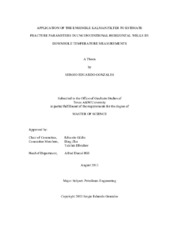| dc.description.abstract | The increase in energy demand throughout the world has forced the oil industry to develop and expand on current technologies to optimize well productivity. Distributed temperature sensing has become a current and fairly inexpensive way to monitor performance in hydraulic fractured wells in real time by the aid of fiber optic. However, no applications have yet been attempted to describe or estimate the fracture parameters using distributed temperature sensing as the observation parameter. The Ensemble Kalman Filter, a recursive filter, has proved to be an effective tool in the application of inverse problems to determine parameters of non-linear models. Even though large amounts of data are acquired as the information used to apply an estimation, the Ensemble Kalman Filter effectively minimizes the time of operation by only using “snapshots” of the ensembles collected by various simulations where the estimation is updated continuously to be calibrated by comparing it to a reference model.
A reservoir model using ECLIPSE is constructed that measures temperature throughout the wellbore. This model is a hybrid representation of what distributed temperature sensing measures in real-time throughout the wellbore. Reservoir and fracture parameters are selected in this model with similar properties and values to an unconventional well. However, certain parameters such as fracture width are manipulated to significantly diminish the computation time.
A sensitivity study is performed for all the reservoir and fracture parameters in order to understand which parameters require more or less data to allow the Ensemble Kalman Filter to arrive to an acceptable estimation. Two fracture parameters are selected based on their low sensitivity and importance in fracture design to perform the Ensemble Kalman Filter on various simulations.
Fracture permeability has very low sensitivity. However, when applying the estimation the Ensemble Kalman Filter arrives to an acceptable estimation. Similarly fracture halflength, with medium sensitivity, arrives to an acceptable estimation around the same number of integration steps. The true effectiveness of the Ensemble Kalman Filter is presented when both parameters are estimated jointly and arrive to an acceptable estimation without being computationally expensive. The effectiveness of the Ensemble Kalman Filter is directly connected to the quantity of data acquired. The more data available to run simulations, the better and faster the filter performs. | en |


